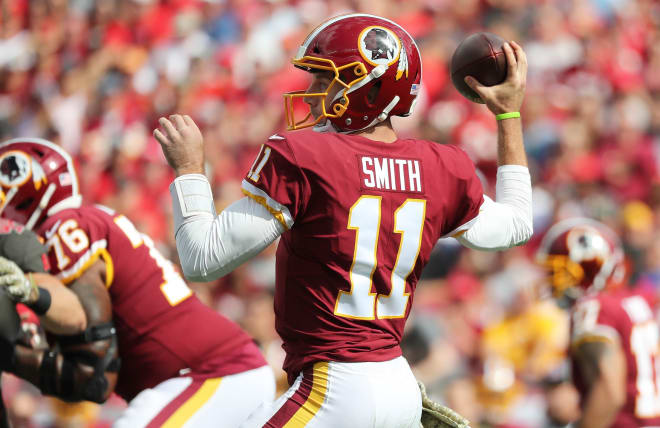Utah Decade Debates: Offensive MVP 2000s

It was the most glorious decade of University of Utah football, especially on the offensive side of the ball. The Utah offenses of the 2000s helped revolutionize the game, and throw the BCS system into chaos.
During that era, two guys stand high above the rest, so let’s get to debating the 2000s decade offensive MVP for the Utes:
Joe Middleton’s pick
Brian Johnson | 2004-2008
A lot of high quality players made their way through the University of Utah football team from 2000-2010. However, only one Utah player can say they won more games than any quarterback in school history. Only one player can say their four-year career culminated in the most important victory in University of Utah football history. That man is Brian Johnson.
As a freshman, Johnson played sparingly. He of course, was backup to Heisman Trophy finalist and future no. 1 overall pick in the NFL Draft, Alex Smith. Led by Head Coach Urban Meyer and Smith, the Utes went undefeated that year and went on to slaughter Pitt in the Fiesta Bowl. That year Utah was the original ‘BCS Buster.’
After the Fiesta Bowl it was time to usher in a new era. An era led by new Head Coach Kyle Whittingham and QB Brian Johnson.
In 2005, Johnson played and started in the first 10 games of the season before suffering an unfortunate season ending knee injury. Johnson was still able to produce impressive numbers without playing the entirety of a season. Johnson threw for 18 TD’s and rushed for another eight scores, all while averaging 289 passing YPG and 48 rushing YPG.
In 2006, football changed for Brian Johnson. For one, he wasn’t going to play any football in 2006 recovering from the knee injury resulting in a redshirt season. For another, Johnson had to realize that due to the injury he probably wasn’t going to be as effective as a running threat that he previously was.
Following the redshirt in 2007, it still took a couple games to get Johnson ready. Finally in game no. 4, Johnson saw some action splitting time with Tommy Grady. After that it was all Johnson all the time. The Utes would go on to win eight of their final nine games that year. The final game being the Poinsettia Bowl vs Navy in which Johnson was named MVP after completing 80% of his passes for 226 yards and TD and rushing for 69 yards and a score.
Now healthy in 2008, Johnson would go on to lead Utah to arguably the most memorable season in school history. Johnson threw for 2,972 yards and 27 scores. But more important than the stats was an undefeated season heading into the biggest game in Utah football history. The Utes got invited to play in the Sugar Bowl vs Alabama, who before their previous conference championship game was ranked no. 1 in the entire country. Utah went on to smash Alabama 31-17. Johnson was named the game's Most Outstanding Player throwing for 336 yards and three scores. Utah would finish the season as the only undefeated team in the country. Although they’re not ‘officially’ or directly correlated, Utah would join the Pac-12 just 18 months later.
An outstanding career bookmarked by undefeated, overachieving seasons for Brian Johnson and the Utes. Johnson would finish off his career as the winningest QB in school history (26 wins), as well as 2nd in career yards (7,853 yards) and 2nd in career TD’s (57) behind Scott Mitchell. To Utah fans, Brian Johnson was a household name. To college football fans across the world, Johnson may forever be recognized as the cover athlete on NCAA Football ‘10 for the Playstation 3. Yet, he’s now making his mark as one of the brightest young position coaches in the college game.
Alex Markham’s pick
Alex Smith | 2002-2004
Surprise surprise… No offense to Brian Johnson, but it’s pretty obvious that Joe got the short stick on this one. I mean, if you choose anyone other than the greatest offensive player in school history, you’d have to have your head examined. Right?
Everyone knows I’ve always been a huge advocate of my podcast buddy and legendary Ute coach, Ron McBride. He can be credited with discovering Smith, but Smith’s ascension into a near mythical legend, doesn’t happen without Urban Meyer.
Coming out of Helix HS, in California, Smith had two offers: Utah and Louisville (with his uncle, John L. Smith). After impressing in practices with a laser arm, McBride and the Utes needed a jolt to save their struggling 2002 season, There was growing speculation that Smith would be that guy, yet his redshirt was removed in a hasty decision during the middle of a game and he preceded to throw only four passes on the season. Needless to say, this left the Smiths not thrilled and had Alex looking to potentially transfer.
Then came Meyer…
After convincing him to stay, by showing him a high-flying offense. Meyer initially elected to go with junior Brett Elliott, who as a dual-threat, was tailor-made for the offense, yet Smith had been nipping at his heels. Two games into the season, the fate of Utah football would change and change forever. Elliott—an eventual NFL quarterback, himself—became Utah’s version of Wally Pipp and Smith and the Utes never looked back.
In 2003, he’d go on to lead the Utes to a 10-2 record (9-1 with Smith as the starter) and a no. 21 ranking. That season Smith threw for 2,247 yards with a 65% completion percentage, he also had a 15/3 touchdown to interception ratio.
What truly made Smith great though, was his decision-making ability. His ability to make the right decision by keeping defenses on their toes was legendary, as he added to his 2003 passing stats with 149 rushing attempts for 452 yards and five touchdowns, yet that still didn’t tell the whole story.
Going into 2004, Meyer convinced the University of Utah marketing department to do a bold campaign, “You ain’t see nothing yet.” And man, was that slogan right.
The Utes would go on to a magical 12-0 BCS busting season, crushing everyone in their path, as Smith led an offense that no one knew how to stop. The Heisman finalist and First-Team All-American threw for 2,952 yards with a 67.5% completion percentage, with a 32/4 touchdown to interception ratio. On the ground, he ran for 631 yards and 10 touchdowns on 135 carries.
The greatest Utes offensive player of the 2000s decade—and of all-time, to be honest—accumulated those 2004 stats, despite being taken out in the third quarter of nearly every game they played.
While unlike Johnson, Smith wasn’t an EA Sports NCAA Football coverboy, he would leave after his junior season and go on to become the no. 1 pick in the 2005 NFL Draft. As his future is in doubt after a devastating leg injury, Smith is a three-time Pro Bowl quarterback, who like Johnson, looks like a future star as a coach.
Ute Nation staff consensus
Like Weddle, there’s really no question here, but Johnson is a no-brainer second choice. Not only did Smith heavily contribute to changing the landscape of the BCS, the QB read-option that he and Meyer developed, has revolutionized the game at all levels, including the NFL.
